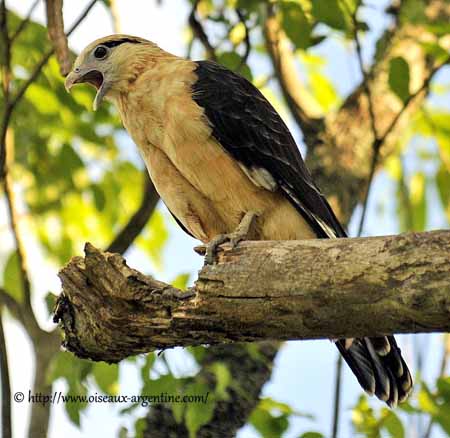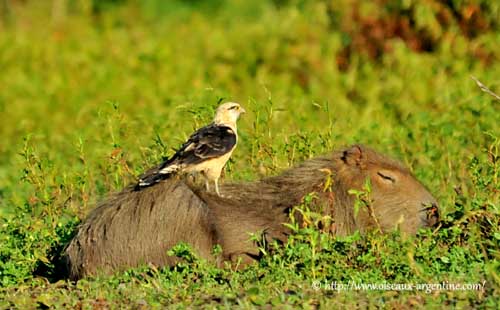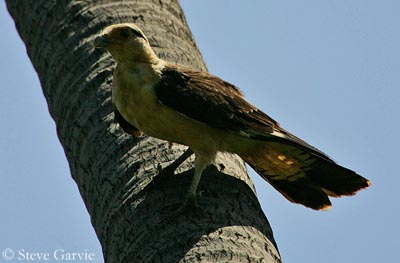
Yellow-headed Caracara
Milvago chimachima
Falconiforme Order – Falconidae Family
BIOMETRICS:
Length : 40-46 cm
Wingspan : 75 cm
Weight : M : 280-330 g – F : 310-360 g
DESCRIPTION:
A fairly small bird of prey commonly seen sitting on the back of cattle or other mammals and taking ticks from them.
Yellow-headed Caracara has dark brown to blackish upperparts. Back and wings are blackish brown. Long wings show large whitish patch at base of outer primaries, very conspicuous in flight.
Buff tail is fairly long and rounded. Uppertail coverts are buff with numerous narrow wavy dusky bars, broad blackish subterminal bar and fine whitish terminal band.
Underparts are pale buff to creamy-white. Underwing shows buffy to creamy-white coverts and blackish-brown flight feathers. Undertail has similar pattern as uppertail.
Head and neck are pale buff to creamy-white, with blackish stripe behind the eye. Lores, base of the bill and eye-ring are bare and yellow, but sometimes they are paler.
Hooked strong bill is horn-coloured. Eyes are reddish-brown. Legs and feet are pale greenish-grey.
Both sexes are similar, with female slightly larger than male.
PROTECTION / THREATS / STATUS:
Yellow-headed Caracara is widespread and common. This species has probably benefited from deforestation for cattle or farming. It is usually seen in urban areas in Latin American cities.
Fr: Caracara à tête jaune
All : Gelbkopfkarakara
Esp : Caracara Chimachima
Ital : Caracara testagialla
Nd : Geelkopcaracara
Russe : Химахима
Photographers:
Steve Garvie
RAINBIRDER Photo galleries
Patrick Ingremeau
TAMANDUA
Philippe et Aline Wolfer
GALERIE
Text by Nicole Bouglouan
Sources :
HANDBOOK OF THE BIRDS OF THE WORLD Vol 2 by Josep del Hoyo-Andrew Elliot-Jordi Sargatal - Lynx Edicions - ISBN: 8487334156
A GUIDE TO THE BIRDS OF COLOMBIA by Steven L. Hilty and William L. Brown
Princeton University Press – ISBN 069108372X
Wikipedia (Wikipedia, The Free Encyclopedia)
Arthur Grosset's Birds (Arthur Grosset)
SORA Searchable Ornithological Research Archive (Blair O. Wolf)

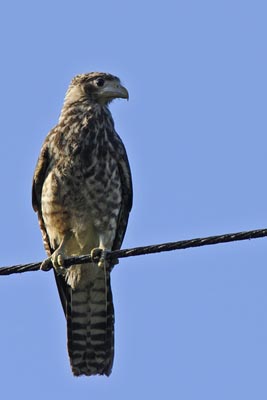
Juvenile is dark brown on the upperparts. Head is dark brown. Underparts are buff, heavily spotted with dull brown. Lower belly is pale buff. Underwing is pale buff, barred and spotted brown. Tail is pale buff with narrower dark brown bars than in adults.
Immature has dull brown upperparts. Head, neck and underparts are buffy, heavily streaked with blurred brown markings.
We find two subspecies: M.c.cordata, and M.c. chimachima.
Yellow-headed Caracara often perches at treetops in small groups. It also patrols along roads and rivers, searching for dead animals, and it follows the ploughs in order to catch the small disturbed animals.
Outside the breeding season, they gather at night-time communal roosts where they spend the night together. They leave the place early in the morning for hunting.
During the breeding season, yellow-headed Caracara becomes more aggressive against rivals, and defends strongly its territory.
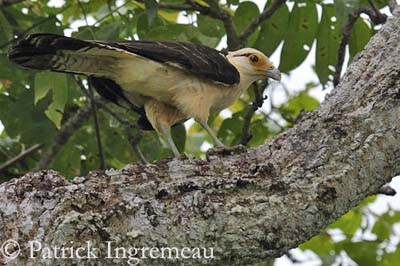
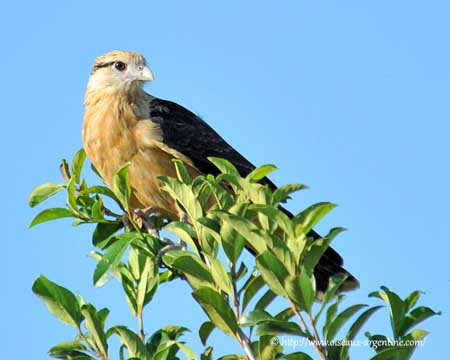
VOICE: SOUNDS BY XENO-CANTO
Yellow-headed Caracara utters typical screams “schreee”, some growling “kraa-kraa-kraa”, and thin, hissing whistles.
HABITAT:
Yellow-headed Caracara frequents open areas with some trees, cultivated areas, pastures, swamps, forest edges and along streams. It is found from sea-level up to 1800 metres of elevation, and locally up to 2600 metres, and recently 3600 metres in Ecuador.
RANGE:
Yellow-headed Caracara is resident in South America, from Costa Rica, Trinidad and Tobago, and southwards to northern Argentina. Also found in Colombia, Venezuela, the Guianas, Brazil, Paraguay and Uruguay.
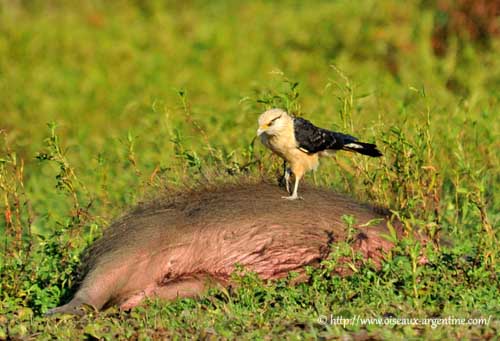
FLIGHT:
Yellow-headed Caracara has buoyant flight. It alternates regular wing beats and occasional sweeping glides.
REPRODUCTION:
Breeding season varies according to the country.
Yellow-headed Caracara builds a large nest with sticks. It is usually situated high in tree, and particularly in palm tree. But it may also nest on mounds in marshes, or on the ground in pampas.
Female lays 1 to 2 buffy eggs with brown markings. Nesting behaviour is unknown, but usually in Falconidae, incubation lasts about one month, and young leave the nest at about 40 days of age.
